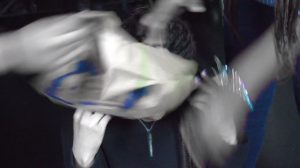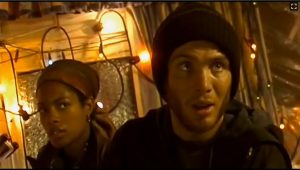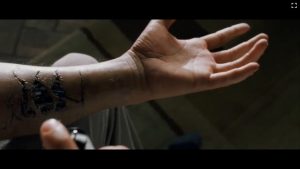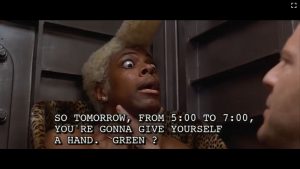PART 1: SEQUENCING
Sequence 1 – Protagonist Explorer One logs onto a computer to access an abstract digital space that is “inthe.net”. We see Explorer One enter the digital space, along with three other Explorers that are key characters in the film.
Sequence 2 – A group of gray-skinned Explorers in the digital space, including Explorer One herself, touch each other as a way to transfer information (or more specifically, memes, gifs, and videos).
Sequence 3 – Explorer One attempts to connect with Explorer Z, who is the antagonist. Explorer Z responds by sending Explorer One a series of photos and memes that depict racism and black hate. Explorer Z then removes the bag from Explorer One, thus exposing her as a black woman.
Sequence 4 – Explorer One is on the ground, trying to put her bag back on her head but two Explorers appear to stop her. They drag her away, and surround her. After a moment, Explorer One disappears. Nothing happens to Explorer Z who also no longer has a bag on his head.
Sequence 5 – A new Explorer enters the digital space, unaware of the events that have passed.
Word Count: 187

Online, it is difficult to control the narratives and representations that proliferate among diverse creators. Indeed, the content produced online can often range from the empowering to the grossly harmful. In our positioning of technology and digital content in the contemporary world, we felt that digital spaces give the illusion of post-racial harmony while actively reinscribing the many forms of harm that visit Black bodies.
This shot is a medium close shot of Ava, playing Explorer One, and 2 sets of hands. The light is across her face while the shadow is falling on the disembodied hands intruding in her space. This frame is disorienting and blurry, as well as cast in black and white, which adds to the confusion. The placement of light on Explorer One’s face highlights her humanity, but it also centers her inability to appear as a disembodied ‘post-racial’ participant in the digital space. Moreover, the hands show the willfulness of elements in the digital space to disrupt the ambiguity supposedly posited by engaging with the digital. Additionally, viewing this frame within the larger context of the film, Explorer One’s face is illuminated in a way that other participants in the digital space were not; this adds to the alienness of her presence and identifies her further as an outsider– if the absence of the bag weren’t enough. We appreciated how disorienting this shot was because of the ways that racialization online is both insidious and unsettling. Racialized attacks come from all directions, at all levels, and can be unending. Like Ava eventually decides, it is sometimes the difference between succumbing or getting out.
Digital spaces offer limitless possibilities in creating space for Black representation. However, given the freedom of the medium, it offers many opportunities for existing racialized representations to be replicated. As Christine Elizabeth Sharpe indicates, “the Web [can] often reproduce the very exclusions and inclusions of our in-person social encounters and alienations” but it can also “constitute an intervention in these power relations” (Sharpe 1093, 1999). The digital runs lateral to reality and thus offers the same spectrum of race relations of person-to-person interactions in real life. For Explorer One, and for many Black users of digital spaces, sharing can be as liberatory as it is limiting.
Word Count: 374



